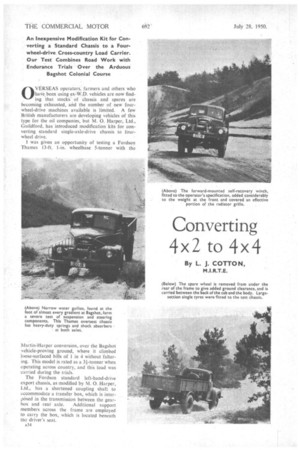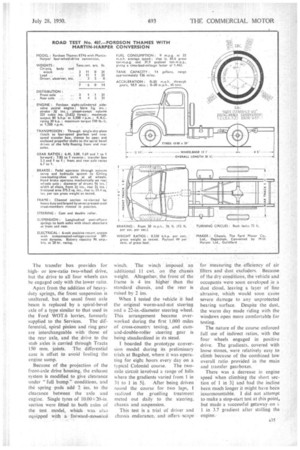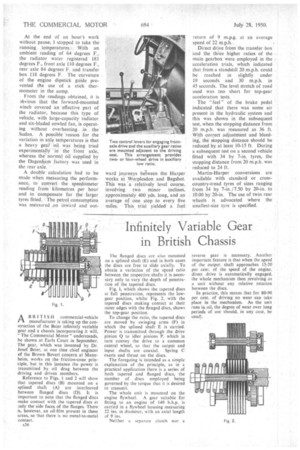Converting 4x2 to 4x4
Page 44

Page 45

Page 46

If you've noticed an error in this article please click here to report it so we can fix it.
By L. J. COTTON, m.i.R.T.E.
An Inexpensive Modification Kit for Converting a Standard Chassis to a Fourwheel-drive Cross-country Load Carrier. Our Test Combines Road Work with Endurance Trials Over the Arduous Bagshot Colonial Course
0 VERSEAS operators, farmers and others who haVe been using ex-W.D. vehicles are now finding that stocks of chassis and spares are becoming exhausted, and the number of new fourwheel-drive machines available is limited. A few British manufacturers are developing vehicles of this type for the oil companies, but M. 0. Harper, Ltd., Guildford, has introduced modification kits for converting standard single-axle-drive chassis to fourwheel drive.
I was given an opportunity of testing a Fordson Thames 13-ft. 1-in. wheelbase 5-tonner with the
-Martin-Harper conversion, over the Bagshot vehicle-proving ground, where it climbed
loose-surfaced hills of l in 4 without faltering. This model is rated as a 3?,-tonner when operating across country, and this load was carried during the trials.
The Fordson standard left-hand-drive export chassis, as modified by M. 0. Harper, Ltd., has a shortened coupling shaft to Iccommodate a transfer box, which is interposed in the transmission between the gear box and rear axle. Additional support members across the frame are employed to carry the box, which is located beneath the driver's seat.
A34 The transfer box provides for highor tow-ratio two-wheel drive, but the drive to all four wheels can be engaged only with the lower ratio.
Apart from the addition of heavyduty springs, the front suspension is unaltered, but the usual front axle beam is replaced by a spiral-bevel axle of a type similar to that used in the Ford WOT.6 lorries, formerly
supplied to the Services. The differential, spiral pinion and ring gear are interchangeable with • those of the rear axle, and the drive to the stub .axles is carried through Traeta
150 mm. joints. The differential case is offset to avoid fouling the engine sump.
Because of the projection of the front-axle drive housing, the exhaust systeni is modified to give clearance under "full bump" conditions, and the spring pads add 2 ins, to the clearance between the axle and engine. Single tyres of 10.00 x 20-in. section were fitted to bath axles of the test. model, whichwax also equipped with . a forward inotin-led
winch. The winth " imposed; 'an additional 11 cwt. on -the chassis. weight. Altogether, the front of the. frame is 4 ins higher: than the standard chassis, and the rear is raised by 2 ins,
When 1 tested the Vehicle it had the original worm-and-nut steering and a 22-in.-diameter steering wheel. This arrangement became overworked during the first 1,000 miles of cross-country testing, and camand-double-roller steering gear is being standardized in its stead.
11 boarded the prototype conversion madel during its preliminary trials at Bagsbot, where it was operating for eight hours every day on a
typical Colonial course, The twomile circuit involved a range of hills where the gradients varied from 1 in
3i to 1 in 5. After being driven round the course for two laps, realized the gruelling treatment meted out daily to the steering, chassis and suspension.
This test is a trial of driver and chassis endurance,and offersscope
cope for for measuring the .efficiency of air "filters and dust ,excluders. . Because Of the dry conditions, the vehicle and occupants were soon enveloped :in.a dust cloud, leaving a layer of fine abrasive, which would soon cause severe damage to any unprotected hearing surface. Despite the dust, the warm day made riding with the windows open more coinfortabte for testing.
The nature of the course enforced full use of indirect ratios, with the four wheels engaged in positive drive. The gradients, covered with loose stones, were relatively easy to climb because of the combined low overall ratio provided in the main and transfer gearboxes.
There was a decrease in engine speed when climbing the short section of 1 in 31 and had the inciine been much longer it might have been insurmountable. I did not attempt to make a stop-start test at this point, but Made a successful getaway on a 1 in 3.7 gradient after stalling the engine.
At the end of an hour's work without pause, 1 stopped to take the running, temperatures.' With an ambient reading of 64 degrees F., the radiator water registered 183 degrees F., front axle 110 degrees F., rear axle 84 degrees F. and transfer box 118 degrees F. The curvature of the engine dipstick guide prevented the use of a stick thermometer in the sump.
From the readings obtained, it is 3bvious that the forward-mounted winch covered an 'effective part of the radiator, because this type of vehicle, with large-capacity radiator and six-bladed cowled fan, is operating without overheating. in the Sudan. A possible 'reason for the variation in axle temperatures is that a heavy gear oil was being tried experimentally in the 'front axle, whereas the normal oil-supplied by the Dagenham factory was used in the rear axle.
A double • calculation had to be made when measuring the performance, to convert the speedometer reading from kilometres per hour and to "compensate for the larger tyres fitted. The petrol consumption was measured on inward and out ward journeys belween the Harper works at Worplesdon and Bagshot. This was 'a relatively level course, involving twa minor inclines, approximately 400 yds. long, and an average of one stop to every five miles. This trial yielded a fuel return of 9 m.p.g. at an average speed of 22 m.p.h.
Direct drive fromihe transfer box and the three higher ratios of the main gearbox were employed in the acceleration trials, which indicated that from a standstill 20 m.p.h. could be reached in slightly under 19 seconds and 30 m.p.h. in 45 seconds. The level stretch of road used was too short for top-gear acceleration tests.
The "feel" of the brake pedal indicated that there was some air present in the hydraulic system and this was shown in the subsequent Lest, when the stopping distance from 20 m.p.h. was measured as 36 ft. With correct adjustment and bleeding, the stopping distance should be reduced by at least 10-15 ft. During a subsequent test on a second vehicle fitted with 34 by 7-in. tyres, the stopping distance from 20 m.p.h. was reduced to 24 ft.
Martin-Harper conversions are available with standard or crossCountry-tread tyres of sizes ranging from 34 by 7-in. /7.50 by 20-in. to 10.00 by 20-in. The use of twin rear wheels is advocated where the smallest-size tyre is specified.












































































